Nice photos!
What’s the model number? I wonder what kind of comb filter it has.

Nice photos!
What’s the model number? I wonder what kind of comb filter it has.
This is an AEG CTV 4800 VT. Likely some cheap thing made at the end of the CRT lifecycle. But as I wrote, the selling point here was that the tube hasn’t seen much action. I was originally talking to someone for possibly getting a nice blue Orion, but that model was considerably older, and the guy couldn’t tell me if the SCART input accepted RGB, so that was a no-go. I’ll probably get another 14 inch one for aesthetics and comparison, and maybe a larger Trinitron if I find one in the 16"-19" range.
That composite is only useful on some 8bit like Atari 2600 and Zx spectrum to hide the jaggies. Everything else looks way better on RGB. I have a Wii and a PC to Trinitron and I can tell you that for sure. 

Some Megadrive games too with heavy dithering. Sometimes though I enable an ntsc shader on that systems to filter the image a bit to look authentic on CRT.
A lot of SNES games relied on composite video tricks as well. Basically anything from the composite video era should use composite video because the graphics were likely designed with that output in mind.
I use GDV and use a custom NTSC mode to minimize undesirable artifacts while still blending stuff that should be blended.
Took some photos recently for social media, might be interesting for some here as well: Wii composite can be very sharp. Still, notable difference with RGB. Third pic is with Blargg’s composite filter activated.
Now, I did get another, older CRT from around 1995, and the composite is notably worse (more color bleeding etc.), but it’s not entirely clear to me to what extent this is due to it’s condition, when I received it, the composite looked so bad I thought it was unusable. After some adjustments I managed to make it look ok, at least for my purposes - it’s an analog chassis (useless service mode), probably won’t mess around too much with the pots, at least for the near future.
Indeed, the comb filters used to re-separate the individual luma and chroma from the composite signal got significantly better (and the best of them got significantly cheaper, making them available in more models) toward the end of the CRT era.
Lovely shots, what TV is it?
Nintendo makes solid AF cables as well which helps. (Cable quality matters, my wallet cries because of it 


You can get component cables for your Wii and your wallet can cry too  )
)
Amiga with composite looks very sharp on early 2000’s Trinitron, of course still not as good as RGB. Still it blends dithering to a new color but nowhere near the blurriness of filters like blargg etc. It’s much more clear and almost no artifacts.
I wholeheartedly agree.
To me most filters that behave like this including GTU Default Settings simulate a composite VHS Tape output signal and not necessarily a good composite signal coming from an NES, SNES or TurboDuo.
Honestly I feel like alot of people associate “shitty composite signals” with VHS/VCRs, unintentionally mind you. (I’m meaning alot of people went composite out of the console, into the VCR and out to the tv either with rf or composite; either way not good, you’re degrading the signal and filtering it additionally by running it through a VCR)
Tldr; People mistakenly think composite is worse than it is because of running it through a VCR causing extra filtering and signal degradation. Also shitty cables = equal noisy, unclear picture.
It’s the same as a couple of posts back (AEG VT 4800, 14-15" size, I haven’t measured it yet). I.e. this is something you would maybe pick up for a low price in a retail store (like Walmart maybe? don’t know about the US). From what I read, it is better to get something that’s essentially “fresh” rather than a CRT from a top-brand that was used thousands of hours. Budget CRT TVs are also supposed to have a potentially more “natural look”, because manufacturers started to shove more and more image processing into their products.
I do have in fact component cables (3rd party, no way I’m going to pay the ridicoulous prices for Nintendo stuff). They’re just pretty useless for CRT TV use in Europe. I got them for 480p LCD use. Funnily enough, 480p was screwed up by Nintendo as well, there was a bug discovered that degraded image quality only fixed via homebrew a few years ago.
Hopefully at the end of the month I’ll be able to test both my CRTs via all three of their inputs with my Mister, just waiting on a different video PCB for it and a component cable.
Should be able to test composite, S-Video, and component. (Just hope my composite/S-Video cable isn’t garbage  ; bought a retrobit Saturn cable)
; bought a retrobit Saturn cable)
lol, “80s”? Most of us were still using the living room TV console from the 70s, because it was the only television in the house. That said, my first one was a cheap RCA 10" B&W “sportable” coupled with a VIC-20 in 1982 – but because it was B&W, it was very crisp.
But when I moved the VIC onto the (big) Zenith color TV, the “chroma noise”(?) it made on the display & speakers meant a LOT of manual adjustment to color / contrast / luma which “muddied” the picture some but was much more tolerable to watch & listen.
I remember there was a huge shortage / backorder of home computer monitors in 1983-1984 with price gouging, and I didn’t get my first one until 1985. But composite video from any set in the 80s were solid given VHS tapes & Camcorders were all the craze. It was the original RF modulator connected to the antenna for a UHF channel (pre-cable 70s TVs) made for the early 8-bit machines that these crappy video artifacts are emulating. The simple CRT Pi effect is enough and making it fit in a retro bezel is more important (to me):
Had an USB grabber around that I used for some VHS conversions, that gave me idea to try to grab Wii and PS2 emulation composite via that and then also see how output would end up on my 95er (Blaupunkt) TV set. Lots of issues popping up though.
Wii composite: Couldn’t get colour for the 60hz mode from the grabber (doesn’t seem to like PAL60 which the Wii outputs instead of NTSC). So I had to stick to 50hz for these.
TV
PS2 composite: None of the recent Retroarch builds with 240p support worked for me. So I had to switch to an FCEU derivate without palette support.  Unlike the Wii, PAL-consoles output NTSC in 60Hz mode. But the TV can’t handle NTSC
Unlike the Wii, PAL-consoles output NTSC in 60Hz mode. But the TV can’t handle NTSC 
Anyway, changing standards for the grabber works, NTSC:
PAL:
Looks like the emulator wrongly scales to 256 lines in the vertical direction instead of keeping it at 240 so you have additional scaling artifacts instead of composite ones 
From TV:
There’s also a half decent C64 emulator in the form of a Vice Port, but it doesn’t change aspect ratio in NTSC mode. So it’s really worth it only for PAL anyway imho.
Grabs:
TV:
Differences aren’t earth shattering, PS composite looks a notch worse than Wii, I think it’s a bit more obvious on my other TVs. The 95er set isn’t that much worse as I initially thought, it’s good deal blurrier, sometimes more dot crawl, e.g. appearing in Wii menus that my other sets don’t have like that.
Yeah that’s not blur actually but it’s like 10-20% opacity of the original raw image moving here and there like convergence or something. The Amiga can do pretty sharp composite too, blending dithering but still sharp.
The CRT shots look sharper than the raw captures, which leads me to believe that it’s something to do with how the CRT works that makes NTSC output on a CRT look sharper compared to any of the shaders I’ve seen.
Alas, here’s GDV at horizontal sharpness 15.00 and subtractive sharpness 1.50, NTSC blend mode = 2.
It seems like the CRT is still sharper, or am I crazy?
(also, my god that red  )
)
Probably too low contrast too, due to mask darkening bright areas too much. Makes the image flat.
The Wii palette was obviously a suboptimal choice, it’s the “PAL” one, afaik the only one not with an NTSC origin. Don’t know what the story behind it is, the process behind palettes is often useful to know. That FCE palette on the PS2 also very much benefits from TV adjustments though, especially for NTSC with my other TVs. I’m going to do some other tests with the 2006 set in the next days.
Anyway here’s something related concerning the possible effects of filtering when dealing with a non-standard signal. Great Hierophant had a writeup on his blog concerning the Apple II, which I recommend to read in full of course.
But here’s the part with illustrations I found most interesting:"The notch filter was about as sophisticated a filtering method as encountered in most composite color computer monitors and TV sets up to the late 1980s. The Apple ColorMonitor IIe a.k.a the AppleColor Composite Monitor IIe and the AppleColor Composite Monitor IIc as well as the Commodore 1084s use notch filters.
The next innovation in luma/chroma composite signal separation was the delay line. With the two line delay system, the monitor would store one line of a signal, extract the luma and chroma from it while the next line was being sent. Because two vertically adjacent lines tend not to have wildly varying colors, when the mostly inverted phases of the color carriers of the two lines are combined they will reduce or cancel each other out leaving much less affected luma than by just using a notch filter.
The two-line delay system was an improvement but it was not perfect and some systems improved on it a little by using a three-line delay system. High frequency horizontal color detail can bleed into the luma channel, leading to “dot crawl”. Additionally, sharp changes in luma can lead to rainbow artifacts and color bleed. To reduce these unsightly artifacts, a more sophisticated adaptive two-dimensional (2D) three line adaptive system was invented to vary the color comparisons over three lines as they were being drawn to best reduce dot crawl. Finally, three-dimensional (3D) motion adaptive comb filters compare the lines of the previous frame with that of the current frame to virtually eliminate dot crawl.
Comb filters work by assuming the signal follows the NTSC rules. Of course, the Apple II signal does not follow the NTSC rules in several respects. First, the Apple II video signal is progressive rather than interlaced. Second, the Apple II does not invert the phase of every other line, the phase starts at the same point in time on every line. This tends to make comb filters behave a little strangely on the Apple II. Because comb filters have to combine the color signal of every pair of lines, they tend to cause a loss of vertical detail. In the Apple II, this detail can result in the blending of alternating single color lines.
Consider this screenshot of Karateka. The ground is being drawn, in canonical Apple II colors, as alternating blue and orange colors. The black and white image (quite commonly seen on the green screens of the day) shows a checkerboard pattern.
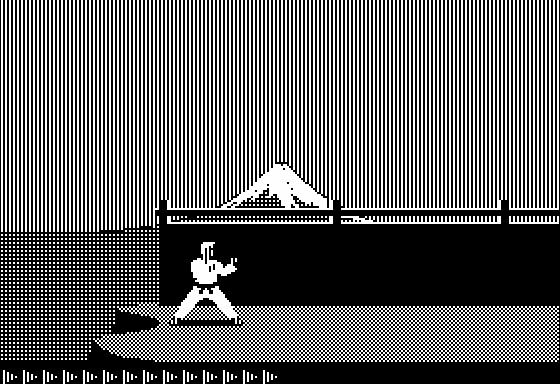 Karateka in Monochrome (raw pixel)
Karateka in Monochrome (raw pixel)
Now consider the pattern through a typical two-line comb filter :
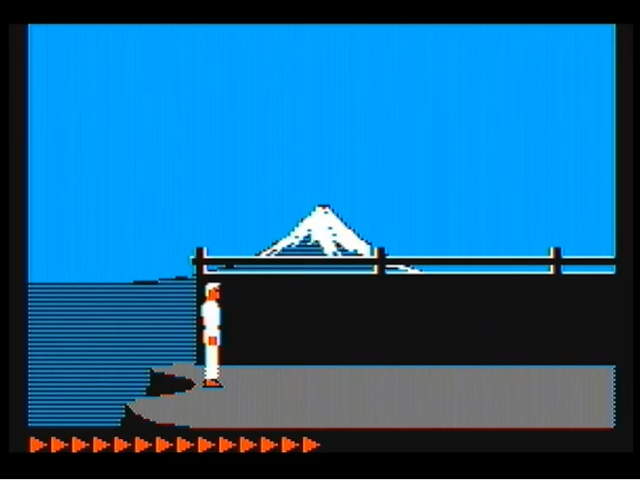 Karateka with Delay Line Comb Filter
Karateka with Delay Line Comb Filter
As you can see, the lines have been blended together to show a gray which would not ordinarily register to the eye as gray. Perhaps the crappiest vintage color TVs may blend these lines together to make a solid gray, but that TV would make for a crappy computer monitor. As blue and orange rely on pixels which are vertically adjacent to each other by one pixel, when you combine them you could get a white signal but due to luma being off over 50% of the line, you get gray instead. The same thing would happen for alternating green and purple lines. However, you can get different colors by mixing colors which are not 90 degrees out of phase with each other.
Finally, let’s consider how a 3D adaptive motion comb filter would handle this image :
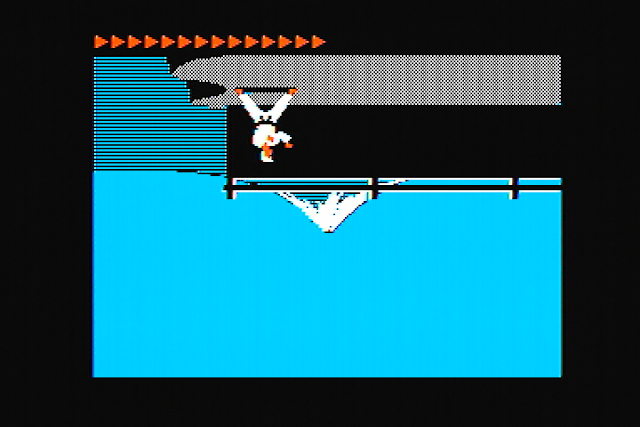 Karateka (Side B) with 3D Motion Adaptive Comb Filter
Karateka (Side B) with 3D Motion Adaptive Comb Filter
As you might note, the sophisticated comb filter has done its job too well here, eliminating virtually all the color, which it sees in this instance as a rainbow artifact to be canceled out. In fact, we have come full circle to reproduce, as well as a capture card can, the original dots making up the video signal! The lack of evenly sized pixels and the resulting scaling artifacts is a symptom of composite/s-video capture cards which only sample composite video at 13.5MHz. As the pixel clock is 7.19MHz, you would need a sample rate of 14.318MHz to fully capture all the pixels without scaling artifacts.
If you look at the back of the box in which Karateka was sold, you should see a gray color to the ground, suggesting that comb filtering was not unknown in the 1980s. But this is not the only example of probable reliance on comb filtering. Consider the title screen to the Bard’s Tale :
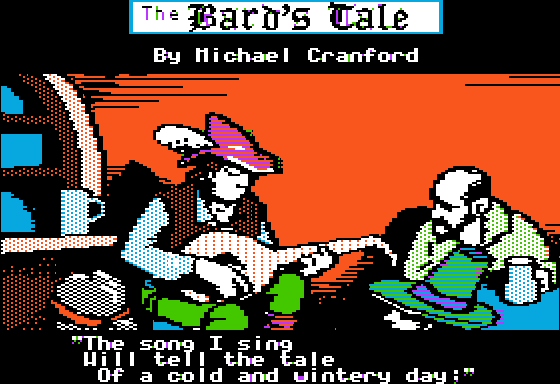 As you see, the hat of the bard and and of one of the listeners has alternating bands of color, orange/purple, green/blue and purple/blue. But consider how a comb filter blends these color bands :
As you see, the hat of the bard and and of one of the listeners has alternating bands of color, orange/purple, green/blue and purple/blue. But consider how a comb filter blends these color bands :
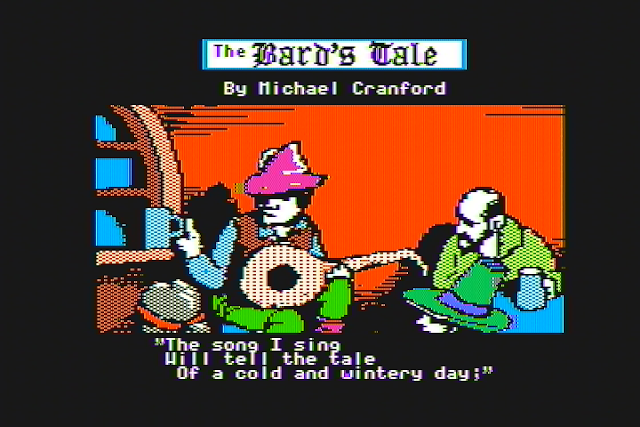 The Bard’s Tale - Delay Line Comb Filter
The Bard’s Tale - Delay Line Comb Filter
Now the Bard’s hat is a solid color pink and the listener’s hat has a green color that is different from the normal green (see the Bard’s pants) and a purplish-blue-ribbon that is not the normal purple or blue hue. If you used a display with a motion adaptive 3D comb filter, you would see dots instead of lines or solid color, something that is definitely not ideal. "
From the comments re: that upside down Karateka pic: “It is not a mistake. It displays upside down relative to the normal way the game is played, but if you look closely, the elements are not mirrored as they should be if I had flipped the image 180 degrees…”